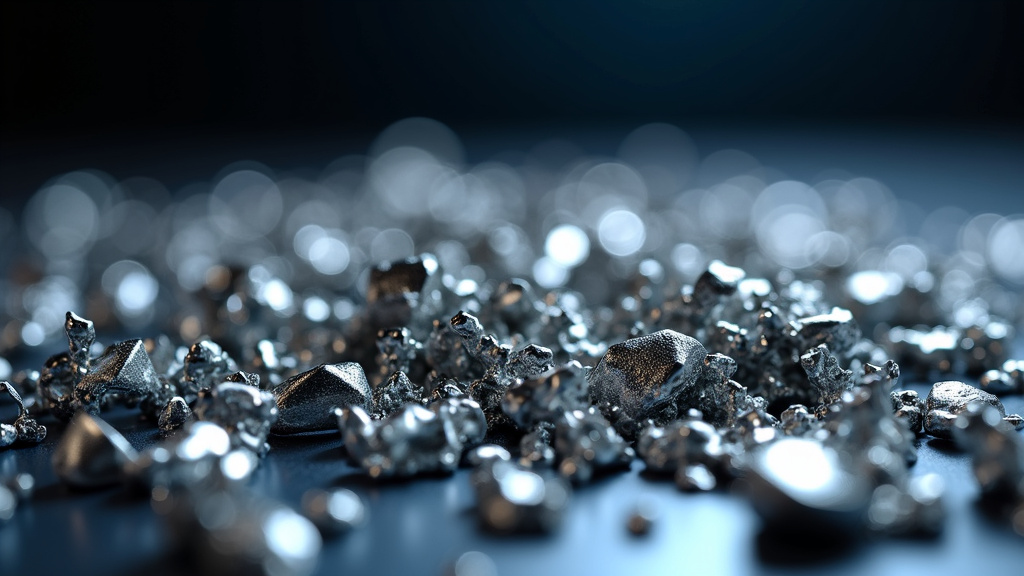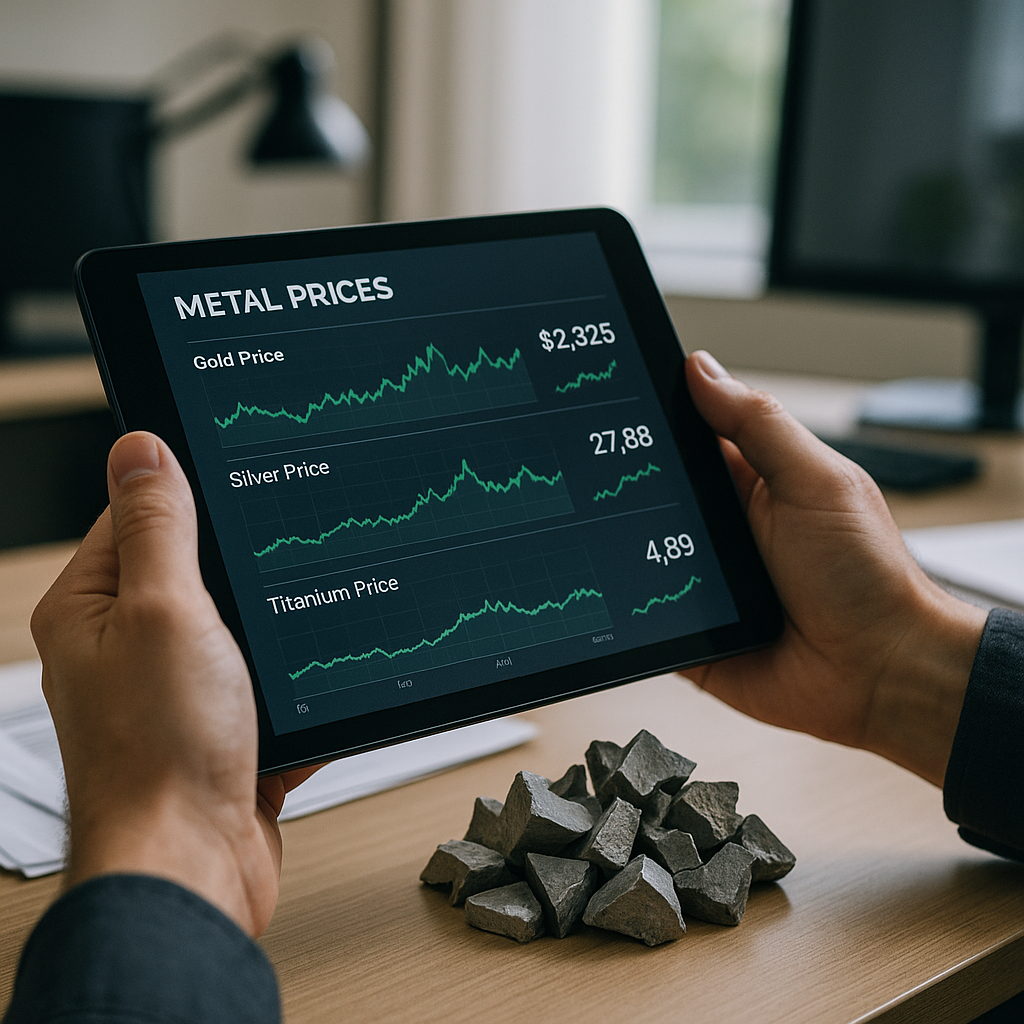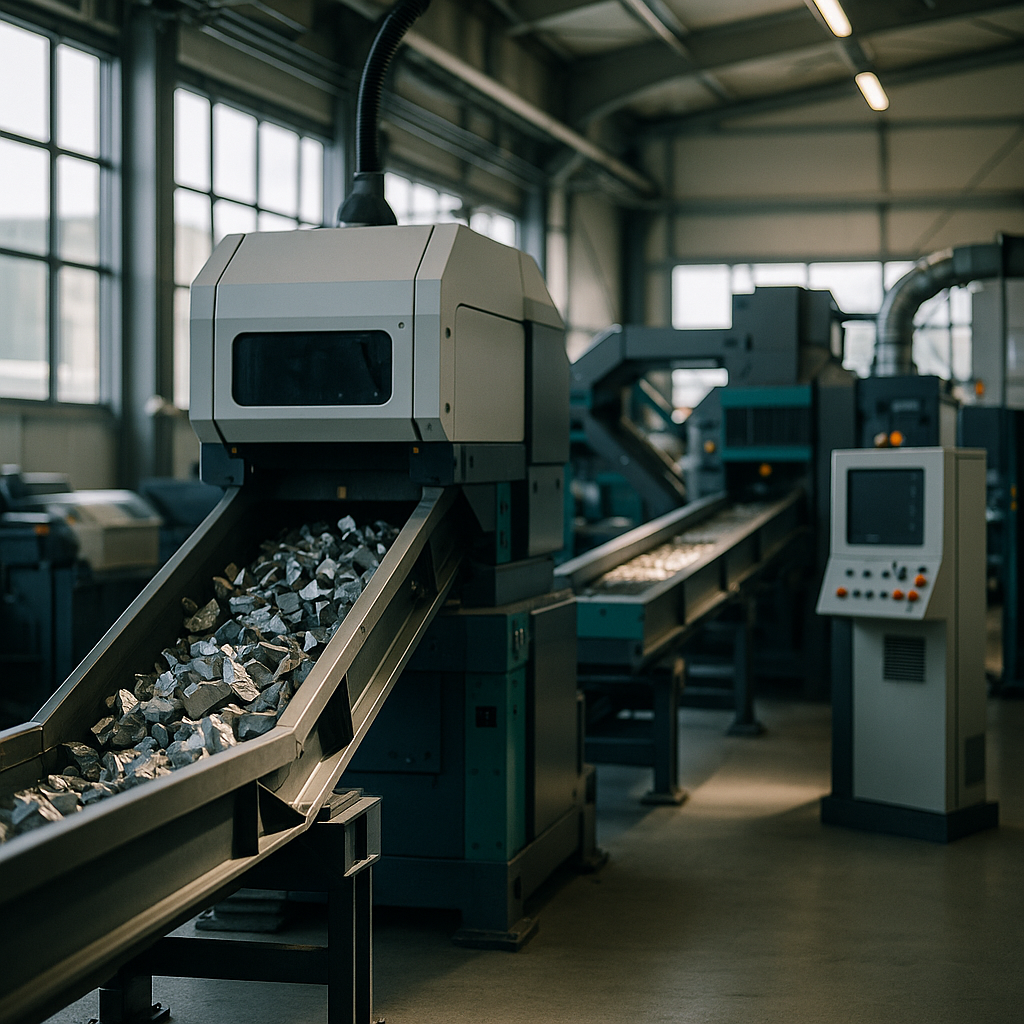5901 Botham Jean Blvd, Dallas, TX 75215
Titanium Scrap: Types, Prices, and How to Maximize Recycling Value
September 28, 2025Titanium scrap is a valuable resource in the recycling industry. It includes leftover materials from manufacturing, decommissioned equipment, and end-of-life products containing this sought-after metal. The aerospace sector generates large quantities during aircraft component production, with up to 90% of raw titanium becoming scrap in the process.
Recycling titanium is economically viable. The material retains its exceptional properties after recycling—its strength, corrosion resistance, and lightweight characteristics remain unchanged. This makes it as valuable as virgin titanium for many uses. The energy savings are also significant. Recycling titanium requires up to 95% less energy than producing it from raw ore.
Many industries actively seek titanium scrap. Aerospace manufacturers use it for aircraft frames, engine components, and landing gear. Medical facilities rely on titanium’s biocompatibility for implants and surgical instruments. Chemical processing plants appreciate its resistance to harsh environments. Even high-performance automotive manufacturers depend on it for critical components.
What Types of Titanium Scrap Can Be Sold?

Titanium scrap appears in various forms, each with different market values and recycling potential. The aerospace industry is a major source of high-value titanium scrap, while manufacturing facilities across multiple sectors also generate recyclable titanium waste. Understanding these different types helps sellers maximize the value of their scrap material.
Commercial Pure Titanium Scrap
Commercial pure titanium (CP titanium) is one of the most straightforward forms of titanium scrap. It contains minimal alloying elements and is valued for its excellent corrosion resistance. CP titanium scrap typically fetches $3.4-3.6/kg ($1.5-$1.55/lb) in current markets.
- Sheet trim and offcuts
- Failed or rejected components
- Unused or excess stock
- Chemical processing equipment remnants
Titanium Solids
Solid titanium scrap consists of larger pieces that maintain their structural integrity. These are highly valued in the recycling market because they require minimal processing before remelting.
- Bulk weldable titanium pieces
- Structural components from decommissioned aircraft
- Large machined parts with minimal contamination
- Unused or rejected forgings
Titanium Alloy Scrap
Titanium alloys, particularly those used in aerospace applications, often command premium prices in the scrap market. Ti-6Al-4V (Grade 5), which contains 6% aluminum and 4% vanadium, is the most common titanium alloy and is widely recycled.
- TC4 (Ti-6Al-4V) scrap: $8.6-11.5/kg ($3.9-$4.2/lb)
- Ti-6Al-2Sn-4Zr-2Mo components
- Ti-6Al-6V-2Sn remnants
- Ti-5Al-2.5Sn structural pieces
Titanium Turnings and Shavings
Machine shops generate significant amounts of titanium turnings and shavings during cutting operations. While these are less valuable than solids due to increased surface area and potential contamination, they remain highly recyclable.
- CNC machining byproducts
- Drilling and milling waste
- Lathe turnings
- Mixed machine shop scrap
Clean, sorted turnings from aerospace operations command higher prices than mixed or contaminated materials from general manufacturing.
Titanium Wire and Rod
Titanium wire and rod remnants are valuable scrap forms. These materials are used in various manufacturing processes and often become available as excess inventory or production remnants.
- Welding wire scraps
- Unused rod sections
- Wire manufacturing remnants
- Medical-grade titanium wire
Aerospace-Grade Titanium Scrap
Aerospace-grade titanium commands the highest prices in the recycling market. These materials often come with material test reports confirming their composition and quality. Aerospace titanium scrap can fetch premium prices, with some high-quality TC4 scrap selling for as much as $5.2/lb at auction.
Aerospace scraps include:
- Aircraft engine components
- Structural airframe parts
- Satellite and spacecraft components
- Defense industry remnants
Factors Affecting Titanium Scrap Value
Several factors influence the market value of titanium scrap beyond the type of material:
- Preparation: Degreased, sorted, and pressure-cake processed scrap can fetch 30-50% higher prices
- Certification: Material with test reports proving composition commands premium prices
- Form: Solid pieces are generally more valuable than turnings or mixed scrap
- Contamination: Oil, grease, or other contaminants significantly reduce value
- Volume: Larger quantities typically receive better pricing
To maximize value, titanium scrap should be cleaned, sorted by grade, and properly identified before selling to recyclers. Some buyers may dock prices significantly for unsorted or contaminated materials.
The market for titanium scrap fluctuates based on global supply and demand factors, particularly in the aerospace sector. With a growing emphasis on sustainability and rising raw material costs, properly sorted titanium scrap continues to be a valuable commodity in the recycling industry.
What Are Current Titanium Scrap Prices?

As of 2025, titanium scrap generally trades between $2 and $4 per pound, with prices varying significantly based on grade, purity, and form. The market has grown steadily since 2021, driven by increased demand across the aerospace, medical, and industrial sectors. Pure titanium scrap commands higher values compared to mixed or contaminated material, reflecting the premium placed on recyclability.
Several factors influence titanium scrap pricing. Grade and composition are crucial—especially aerospace-grade titanium (Grade 5/Ti-6Al-4V), which commands premium prices due to its specialized applications. Material form also matters; solid, uncontaminated pieces typically fetch higher prices than turnings or shavings mixed with cutting fluids. Regional markets show notable price variations, with aggressive buying in Asia, particularly China, often leading to higher price points than those in North America and Europe.
Commercial processing significantly impacts value. Properly prepared scrap—degreased, sorted by grade, and compressed—can sell for 30-50% more than loose, mixed material. This processing reduces transportation costs by up to 75% while increasing material density to approximately 5.2g/cm³, making it more attractive to recyclers and manufacturers.
For comparison, commercially pure titanium (Grades 1 & 2) currently trades at $6 to $10 per pound, making it significantly more expensive than scrap but still a cost-effective option for many industrial applications. Meanwhile, premium Grade 5 titanium alloy commands $15 to $30 per pound, reflecting its critical importance in aerospace and medical applications.
Market analysts forecast continued price stability for titanium scrap through 2025, with potential increases driven by expanding applications in aerospace manufacturing and electric vehicle production. The global push toward sustainability is also strengthening the titanium recycling market, as manufacturers seek to reduce costs while minimizing environmental impact. This trend supports long-term price stability for high-quality titanium scrap.
How to Sell Titanium Scrap for Maximum Value
Selling titanium scrap can be lucrative if you understand how to maximize its value. Proper preparation and knowledge of market conditions are key factors that determine the price you’ll receive. Explore practical strategies to help you get top dollar for your titanium materials.
Properly Sort and Categorize Your Titanium
Sorting is the first crucial step in maximizing scrap value. Separate different grades and types of titanium scrap meticulously. This makes it easier for buyers to assess your material, typically increasing the overall value of your lot.
Start by dividing your titanium into categories such as pure titanium (Ti), titanium alloys (like TC4), turnings, and solid pieces. Higher-grade aerospace or medical titanium commands premium prices, often 2-3 times more than mixed alloys.
Use a small magnet to help identify pure titanium, which is non-magnetic. This simple tool can help you sort materials more accurately, potentially commanding higher prices for purer materials.
Clean and Prepare Your Scrap
Thorough cleaning significantly increases value. Remove any oils, greases, or contaminants that could affect quality and recycling efficiency. Oil content directly impacts melting costs, and buyers will pay more for clean material.
Consider cutting larger pieces into manageable sizes. Many buyers have specific size requirements, and meeting these specifications can make your scrap more attractive and easier to transport.
For industrial titanium, proper density matters. Professional pressure cake processing can increase density to around 5.2g/cm³, reducing transportation costs by up to 75% and potentially increasing purchase prices by 30-50%.
Research Current Market Conditions
Stay informed about current titanium scrap pricing trends. The market fluctuates based on factors like global demand, industrial needs, and raw material availability. Timing your sales when demand is high can yield significantly better returns.
Monitor industry publications and metal recycling reports for insights into pricing trends. Understanding the cyclical nature of the scrap metal industry helps you strategically time your sales for maximum profit.
Current market rates vary widely based on grade and quality. Pure titanium scrap typically fetches $3.40-3.60/kg, while aerospace-grade titanium alloy can command substantially higher prices.
Document Material Quality and Origin
Maintain thorough records of your scrap’s origin and composition. This transparency builds trust with buyers and can lead to better pricing. For high-grade materials, certification documentation can significantly increase value.
If you have high-quality aerospace or medical titanium, providing material test reports and certification may increase the price you receive by 15-20%. Verified titanium scrap with known alloy composition is much more valuable to specialized manufacturers.
Traceability is particularly important for buyers who need to meet stringent manufacturing specifications. Well-documented materials remove uncertainty and risk for buyers.
Work with Specialized Buyers
Seek out specialized titanium recyclers rather than general scrap yards. These specialists better understand titanium’s value and can offer more competitive prices, especially for higher-grade materials.
Research potential buyers thoroughly. Contact multiple recyclers for quotes, as prices can vary significantly between buyers. This comparison ensures you get the best possible deal.
Consider building relationships with industrial buyers directly. Manufacturing companies that use titanium may purchase scrap directly, especially if it meets their specific alloy needs. These direct relationships often yield better prices by cutting out middlemen.
Optimize Your Selling Strategy
Consider selling in bulk when possible. Buyers typically pay more per pound for larger quantities since bulk purchases lower their processing costs. Combining smaller amounts over time to achieve more favorable rates can be worthwhile.
Be prepared to negotiate. Many buyers start with lower offers expecting negotiation. Having knowledge of current market rates and multiple quotes gives you leverage in these discussions.
Establish ongoing relationships with reliable buyers if you regularly generate titanium scrap. These relationships can lead to preferred pricing and more streamlined selling processes over time.
Consider Transportation and Logistics
Factor in transportation costs when evaluating offers. A slightly lower price from a local buyer may yield better net returns than a higher price requiring significant shipping expenses.
Ensure proper packaging and labeling of your materials for transport. Well-organized shipments reduce handling issues and demonstrate professionalism, potentially leading to better business relationships.
Always adhere to safety regulations and documentation requirements when transporting scrap metal. Compliance protects you legally and builds trust with buyers.
Conclusion: The Future of Titanium Scrap Recycling

The titanium scrap market is poised for significant growth, with forecasts predicting prices will reach $10 to $12 per pound by 2028. This increase is driven by economic and sustainability factors, underscoring the metal’s value in the circular economy and its essential role in advanced manufacturing sectors.
Several key drivers are influencing this growth. The aerospace industry, with its reliance on titanium for newer, lighter aircraft, remains a primary source of demand. Additionally, medical applications and sustainable manufacturing initiatives contribute to market pressure. As global supply chains face ongoing challenges and raw material constraints tighten, recycled titanium’s role as a stable, environmentally responsible material source is crucial for industries that depend on this strategic metal.
For businesses and municipalities aiming to enhance their scrap metal recovery programs or invest in sustainable material streams, it is an opportune moment to assess titanium recovery operations. Contact Okon Recycling at 214-717-4083 for expert guidance on titanium scrap handling, processing solutions, and insights to maximize the value of your recycling program.
